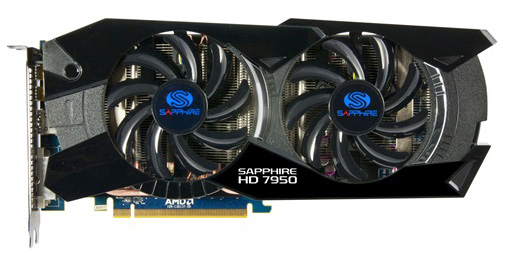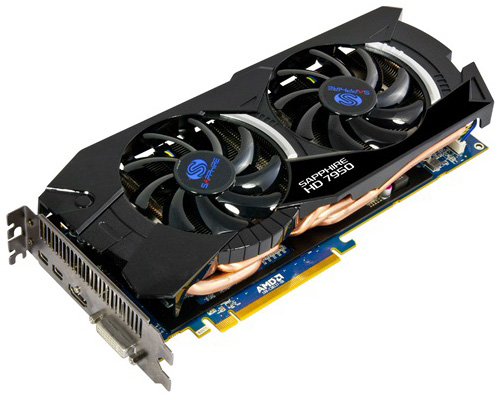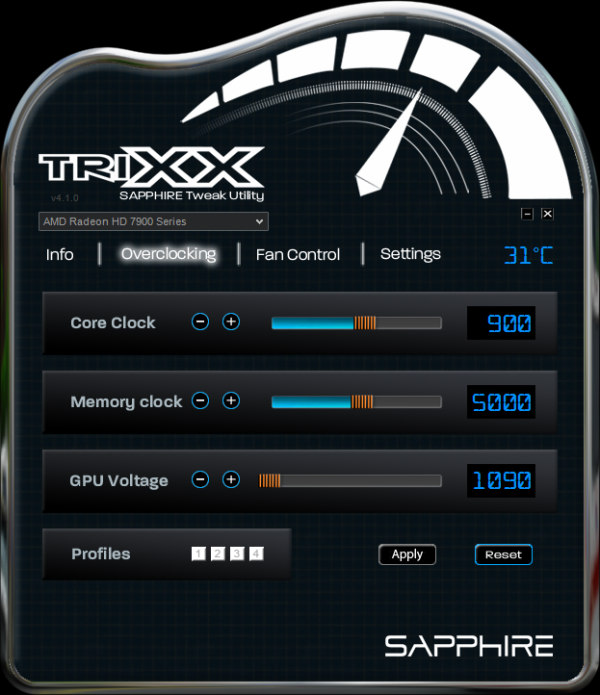AMD Radeon HD 7950 Review Feat. Sapphire & XFX: Sewing Up The High-End Market
by Ryan Smith on January 31, 2012 9:02 AM ESTMeet the Sapphire HD 7950 Overclock Edition
Since our reference 7950s are built on the 7970 PCB and cooler, we’re going to jump right into our vendor cards starting with the Sapphire HD 7950 Overclock Edition.
As with all of the 7950 cards launching today, Sapphire’s HD 7950 Overclock Edition uses the AMD 7950 PCB. This is a slightly shorter PCB measuring 10.25” long, saving .25” over the 7970 PCB by eliminating a few components that the lower board power of the 7950 makes unnecessary. The PCB is otherwise very similar to the 7970 PCB, utilizing 12 GDDR5 memory chips organized around the Tahiti GPU, while at the top you’ll find the 2 CrossFire connectors, a pair of 6pin PCIe power sockets, and the BIOS selection switch. The latter will be of particular interest to unlockers, as the switch should make it possible to safely attempt to unlock the 7950 into a 7970.

Moving on, as this is a semi-custom card the real differentiation is in the factory overclock and the cooler. On the performance side of things Sapphire will be shipping the 7950 Overclock Edition at 900MHz core and 5GHz memory, representing a 100MHz (12.5%) core overclock and no change on the memory clock.
Meanwhile for the cooler Sapphire is using what they’re calling the Dual-X cooler. The Dual-X is yet another double-wide dual-fan open air cooler, with 2 fans providing copious airflow over an aluminum heatsink running virtually the entire length of the card. Sapphire’s fan cutouts are just a bit bigger than most other dual-fan coolers and placed a bit higher, and as a result the Dual-X cooler is a bit taller than the PCB by about 15mm at its highest point. Meanwhile the cooler is also a fair bit longer than the PCB, putting the total card length at 11”.
Moving below the fans and the heatsink we’ll find the heatpipe assembly, which is responsible for carrying heat from the GPU to the heatsink. The Dual-X uses 5 copper heatpipes of varying radius that run from one end of the heatsink to the other. The 5 heatpipes converge at the base of the assembly, where a copper baseplate provides contact with the GPU. Meanwhile cooling for the VRM MOSFETs and RAM is provided by a black aluminum plate, which is placed over those components with heat transfer provided by the use of thermal pads. There is no connection between the plate and the heatsink, so the only heat dissipation from the plate is provided by whatever airflow from the fans reaches the plate.

At the front of the card we’ll find the display ports, which as this is an AMD PCB the card utilizes the standard AMD 7000 series port configuration of 1 DL-DVI port, 1 HDMI port, and 2 mini-DisplayPorts. Filling out the second slot is the grating for ventilation, though even with the ventilation slot the usual precautions for an open-air cooler apply: you’ll need a case with enough airflow to handle the roughly 200W of heat the card is capable of dumping inside of your case.
Rounding out the package is the usual collection of dongles and materials. Sapphire includes 2 molex-to-6pin PCIe adaptors, an HDMI to DVI dongle, a miniDP to DisplayPort dongle, a DVI to VGA dongle, and a 1.8m HDMI cable. Along with the dongles Sapphire packs a quick start guide and a driver installation CD.
The only thing you won’t find packed in the box is TriXX, Sapphire’s in-house overclocking utility. TriXX has been around since the 6900 series, but as this is the first high-end Sapphire card we’ve reviewed since it was released, this is the first time we’ve had it available for a review.
Fundamentally TriXX is a fairly well designed, albeit barebones overclocking utility. Along with an info readout similar to GPU-Z, TriXX provides overclocking and fan control support for Sapphire’s cards, including support for custom fan profiles and more importantly voltage control. With TriXX it’s possible to overvolt most of Sapphire’s performance and high-end cards, and as Sapphire uses AMD reference PCBs it also works with any other cards using AMD’s PCBs.
Beyond these features there’s little more to TriXX. It’s not an all-encompassing video card utility like MSI’s Afterburner, which means it comes up short if you need more functionality but it's exactly what you need if you just want to overclock. To that end it’s a clear step up compared to most other manufacturer’s poorly designed utilities, and from a design perspective its only real sin is the hard to read blue-on-black text. Otherwise it’s a competent overclocking utility that does exactly what it’s supposed to and provides voltage control for those who need it.
Finally, Sapphire will be selling the 7950 OE for $479, $30 over the baseline 7950 MSRP. Meanwhile the warranty on their card is their standard 2 year warranty.















259 Comments
View All Comments
chizow - Sunday, February 5, 2012 - link
You want to talk about respect while throwing out inflammatory comments like fanboy every reply while ignoring the actual facts and logic of an argument? Respect is given where its due.Anyways, like I said, just draw out the pricing history on these high-end parts for the last 5-6 years and you will see what AMD is doing here is unprecedented. At no point has one of these GPU makers ever asked for flagship prices with so little improvement over the last-gen flagships when using a new process node/GPU architecture.
If you are a reasonable person who is deserving of respect, I think you will find truth and reason in what I've written here, fanboyism and lack of respect aside.
Galidou - Sunday, February 5, 2012 - link
Find me anywhere I called you an idiot or a stupid or anything, the worse I said is that ultimate knowledge is crazyness, never called you crazy or ANYTHING, while you did it again., sad to see you have to resolve to those strategy as arguments....The lowest price I can find right now of the 7970 is 520$ and lowest I can find for 6950 is 240$, a little more than double as I said.
I said I trolled and I know it inflammatory comments and lack of respect is different, I was poking your ''facts'' and the way you react and still lack of respect toward me just shows even more...
''who is deserving of respect''
EVERYONE deserves respect and I will still respect you even if you don't for me because respect can't be bought, it is acquired or applied...
Galidou - Sunday, February 5, 2012 - link
And btw you still forgot to input the amount of memory which is 3gb that you forget everytime in your comments....Galidou - Sunday, February 5, 2012 - link
''If you are a reasonable person who is deserving of respect''I just still can't beleive you said that... ''who is deserving respect'' it's deceiving to see such lack of respect in a conversation about gpus,
I understand what you mean, Nvidia as always been about giving double the performance of last gen but they are hitting a wall where it won't be possible until they change the limit of the max TDP which is 300w, they are very close to it, I guess they left some space for double chip cards, but nvidia which isn't their strenght of watt/performance will probably have to change things if they want to squeeze double the gtx580 in their gtx680 in 300w TDP...
Considering ATI are the best at watts/performance and they only squeezed that kind of performance in 250w.....
chizow - Sunday, February 5, 2012 - link
6950 was as cheap as $180-$200 in some sales and the 7970 is $550-$600, so yes at times it was 3x.But the point remains, the 7970 does a worst job at upholding your standard than the GTX 280.
Also, it was a full 2x framebuffer, 8800GT was only 512MB, same as the 9800GX2 which was a massive amount of VRAM at the time. It was also more than the 512MB on the original 4870 with a full 512-bit bus.
Once again, the 280 was a flagship card by every metric, if you want to argue honestly over the facts, at least try to be honest about it.
Galidou - Sunday, February 5, 2012 - link
Yes you're right the 8800gt was 512mb, wasn'T there a 1gb version? I can'T remember...4870 was cheating, it used the first ddr5 memory so it doubled the bandwidth without adding die size, which helped ALOT to it'S great performance, I still like my 4870 which can almost still run everything very well...
Galidou - Sunday, February 5, 2012 - link
ok you want to go in the ''as cheap as'' well my friend got right after me a rebate with special and had a 8800gt for 150$ after everything, I was using regular price for my 8800gt at 180$, so consider a 8800gt at 150$ times 4.33 = 650$, wow, 4 times and a third....Galidou - Sunday, February 5, 2012 - link
IT WAS A FLAGSHIP CARD LOL the radeon 4870 got so close to it with a die half as big and that was what, a month and a half later... speak about flagship at 650$Galidou - Sunday, February 5, 2012 - link
worse than that, the radeon 4870 wasn't even meant to compete with the high end, AMD had left that market for single GPU but still it came SO CLOSE... speak about Flagshipn amzingness that doubles the previous generation.....Galidou - Sunday, February 5, 2012 - link
If you find something to say against my last comment I'm over with you, your closed mind will be the strognest I have ever seen. He will find a reason of the gtx 280 selling so high because of the Nvidia's CEO not having enough food on the table so they had to adjust the price....Poor them, send them food, they're starving!!